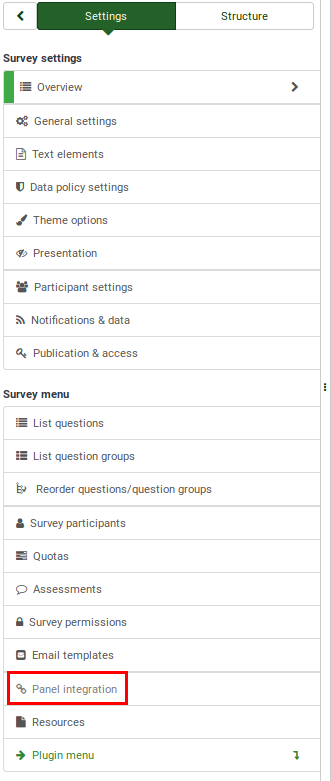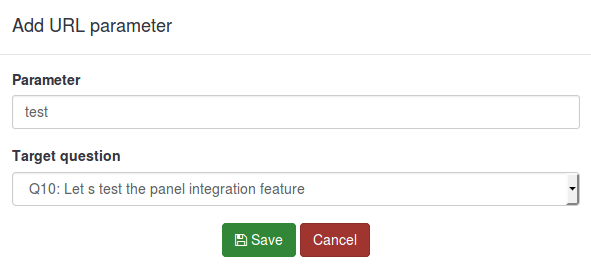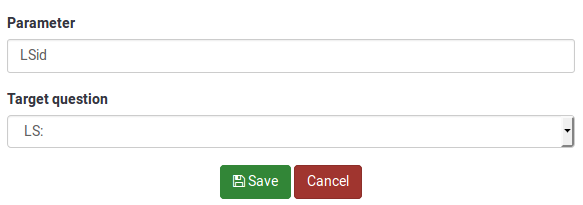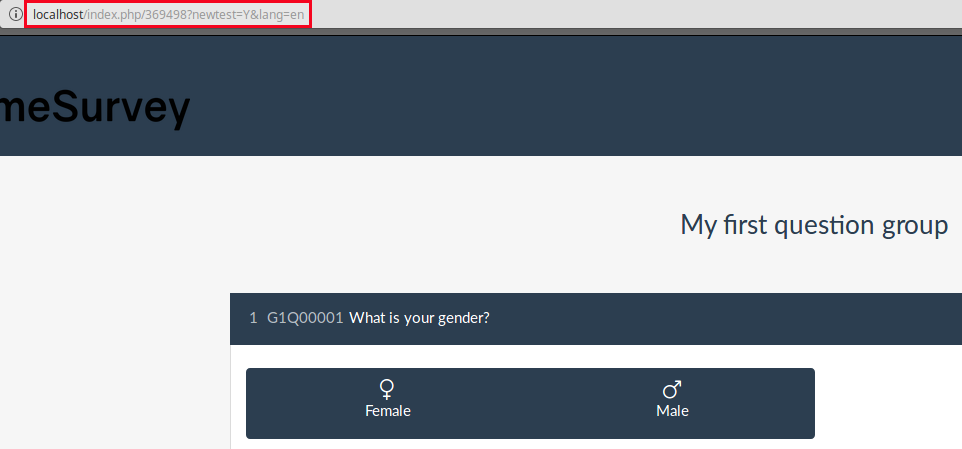Panel integration: Difference between revisions
From LimeSurvey Manual
(Marked this version for translation) |
m (Removed nonsense) |
||
| (14 intermediate revisions by 3 users not shown) | |||
| Line 7: | Line 7: | ||
<!--T:43--> | <!--T:43--> | ||
<div class="simplebox">[[File:help.png]] The | <div class="simplebox">[[File:help.png]] The following examples and explanations are based entirely on our users' contributions. Feel free to contribute if you want to help to expand our open knowledge about panel integration.</div> | ||
| Line 14: | Line 14: | ||
<!--T:41--> | <!--T:41--> | ||
From this tab you can define the URL parameters that will be accepted by your survey. (These parameters will be attached to the general survey start URL). This option is important if you want to integrate your survey with a professional survey panel provider that provides the participants for you. The latter usually provides the unique ID of every survey participant and you will need to save these unique IDs for further reference. | |||
<!--T:45--> | <!--T:45--> | ||
{{Alert|title=Attention|text=With some providers, the unique ID of the participant that | {{Alert|title=Attention|text=With some providers, the unique ID of the participant that will be omitted due to a quota limitation or when finishing the survey, needs to be sent back to the panel provider in the survey end URL or quota URL.}} | ||
<!--T:46--> | <!--T:46--> | ||
Survey's panel integration: '''Survey menu''' > '''Survey menu''' > '''Panel integration''' | |||
<!--T:47--> | <!--T:47--> | ||
<center>[[File:Panel integration - tab.png]]</center> | <center>[[File:Panel integration - tab.png]]</center> | ||
=Survey panel integration= <!--T:48--> | =Survey panel integration= <!--T:48--> | ||
| Line 32: | Line 31: | ||
<!--T:49--> | <!--T:49--> | ||
An empty table will be displayed with the option that allows you ''to add an URL parameter''. | |||
| Line 40: | Line 39: | ||
<!--T:51--> | <!--T:51--> | ||
Two fields | Two fields need to be filled out: | ||
<!--T:52--> | <!--T:52--> | ||
| Line 46: | Line 45: | ||
<!--T:53--> | <!--T:53--> | ||
*'''Parameter:''' Type in this field the name of the new parameter. | *'''Parameter:''' Type in this field the name of the new parameter. | ||
*'''Target question:''' | *'''Target question:'''. The value of the parameter is always saved in the survey session, even if you don't set a target question here. Here, you can select a question of type 'Sort text' or 'Multiple texts'. | ||
<!--T:20--> | <!--T:20--> | ||
<div class="simplebox">[[File:help.png]] | <div class="simplebox">[[File:help.png]] If you do not save the value of the URL parameter, you will still be able to use this parameter in the end URL. For further documentation, continue reading the [[URL_fields#Passthrough_fields|End-URL]] wiki section.</div> | ||
==How to use the panel integration function== <!--T:54--> | ==How to use the panel integration function== <!--T:54--> | ||
| Line 57: | Line 55: | ||
<!--T:55--> | <!--T:55--> | ||
A [https://www.limesurvey.org/forum/design-issues/95878-how-to-use-the-panel-integration-fuction simple example] is presented below | A [https://www.limesurvey.org/forum/design-issues/95878-how-to-use-the-panel-integration-fuction simple example] is presented below to explain how to use the panel integration function. | ||
<!--T:56--> | <!--T:56--> | ||
1) First, create a '''short/long free text question''' and name it what ever you want (we will use "LS" for the '''Question code''' field). Then, enable the '''always hide this question''' option, located under the '''Display''' tab within the menu of the question. | 1) First, create a '''short/long free text question''' and name it what ever you want (we will use "LS" for the '''Question code''' field). Then, enable the '''always hide this question''' option, located under the '''Display''' tab within the menu of the question. | ||
<!--T:58--> | <!--T:58--> | ||
2) Go to the panel integration tab, and click | 2) Go to the panel integration tab, and click the "Add URL parameter". | ||
<!--T:59--> | <!--T:59--> | ||
Select the short/long text question you created in the first step. The | Select the short/long text question you created in the first step. The participants that come from the respective professional panel provider will land on the '''target question'''. It can be hidden so that the participants can start completing the survey. | ||
| Line 79: | Line 73: | ||
<!--T:61--> | <!--T:61--> | ||
The name you pick for the parameter will have to be included in the entry link that you will later supply to your panel provider. It will be named "LSid" in our example. Don't forget to click | The name you pick for the parameter will have to be included in the entry link that you will later supply to your panel provider. It will be named "LSid" in our example. Don't forget to click the '''Save''' button located in the upper right part of the table! | ||
<!--T:62--> | <!--T:62--> | ||
3) Now, you have to set up the entry link that you will send to the your panel provider. To get your survey URL link, click | 3) Now, you have to set up the entry link that you will send to the your panel provider. To get your survey URL link, click the '''Preview survey''' buttons. | ||
| Line 99: | Line 93: | ||
<!--T:92--> | <!--T:92--> | ||
<div class="simplebox">[[File:help.png]] '''Hint''': The "newtest" parameter is used | <div class="simplebox">[[File:help.png]] '''Hint''': The "newtest" parameter is used to reset the session. This is useful when you wish to test locally the panel integration or when you know that your participants are using the same device/browser to fill out the survey. Therefore, adding "newtest=Y" in the survey URL creates new answers in the responses table by forcing the creation of a new session regardless of the used device/browser..</div> | ||
| Line 115: | Line 109: | ||
<!--T:69--> | <!--T:69--> | ||
What ever you replace the "xxxxxx" with will be | What ever you replace the "xxxxxx" with will be stored in the short/long free text question when your respondent lands on that page. For example, I sent to a user the following link: | ||
<!--T:70--> | <!--T:70--> | ||
| Line 137: | Line 131: | ||
<!--T:74--> | <!--T:74--> | ||
The following examples were created | The following examples were created to help you add: | ||
<!--T:75--> | <!--T:75--> | ||
| Line 145: | Line 139: | ||
<!--T:76--> | <!--T:76--> | ||
<div class="simplebox">[[File:help.png]] '''Note:''' parametername={PASSTHRU:parametername}" provides the panel provider the id of the | <div class="simplebox">[[File:help.png]] '''Note:''' parametername={PASSTHRU:parametername}" provides the panel provider the id of the participant.</div> | ||
<!--T:77--> | <!--T:77--> | ||
{{Alert|title=Attention|text=The solutions provided below make use of the [[URL_fields#Passthrough_fields|'''passthrough fields''']]. Please note that | {{Alert|title=Attention|text=The solutions provided below make use of the [[URL_fields#Passthrough_fields|'''passthrough fields''']]. Please note that besides "'''parametername={PASSTHRU:parametername}'''", everything else has to be provided by your panel provider!}} | ||
| Line 156: | Line 150: | ||
<!--T:79--> | <!--T:79--> | ||
The complete link | The complete link must be inserted into [[Text elements|the end URL field]] that also has [[Presentation#Presentation_panel|to be loaded automatically]] for everyone who successfully completes the whole survey. | ||
<!--T:80--> | <!--T:80--> | ||
| Line 165: | Line 159: | ||
<nowiki>https://panelproviderwebsite.com/?return=complete¶metername={PASSTHRU:parametername}</nowiki> | <nowiki>https://panelproviderwebsite.com/?return=complete¶metername={PASSTHRU:parametername}</nowiki> | ||
</code> | </code> | ||
==The screenout link== <!--T:82--> | ==The screenout link== <!--T:82--> | ||
| Line 171: | Line 164: | ||
<!--T:83--> | <!--T:83--> | ||
A screenout | A screenout prevents the participants from continuing the survey because he or she is not a member of your survey target group. For screenouts, you have to set the quota limit field to "0" (zero) and allow the quota URL to be automatically loaded once it was triggered. | ||
<!--T:84--> | <!--T:84--> | ||
| Line 183: | Line 176: | ||
<!--T:86--> | <!--T:86--> | ||
<div class="simplebox">[[File:help.png]] '''Note:''' Read the following wiki section to find out more about the [[Survey quotas|LimeSurvey quota system and its usage.]]</div> | <div class="simplebox">[[File:help.png]] '''Note:''' Read the following wiki section to find out more about the [[Survey quotas|LimeSurvey quota system and its usage.]]</div> | ||
==The quotafull link== <!--T:87--> | ==The quotafull link== <!--T:87--> | ||
| Line 199: | Line 191: | ||
<!--T:90--> | <!--T:90--> | ||
{{Box|This is not the only solution you can use to implement quotafull, complete and screenout redirects to your panel provider! For example, the [[ | {{Box|This is not the only solution you can use to implement quotafull, complete and screenout redirects to your panel provider! For example, the [[ExpressionScript - Presentation]], the [[SGQA_identifier|SQGA indentifiers]], and the [[URL fields]] offer you different workarounds to complete the same tasks (and even the more complex ones). For additional help, check also the [https://www.limesurvey.org/forum LimeSurvey forum].}} | ||
=Survey panel integration via expressions= <!--T:93--> | =Survey panel integration via expressions= <!--T:93--> | ||
Latest revision as of 21:30, 11 June 2023
Introduction
From this tab you can define the URL parameters that will be accepted by your survey. (These parameters will be attached to the general survey start URL). This option is important if you want to integrate your survey with a professional survey panel provider that provides the participants for you. The latter usually provides the unique ID of every survey participant and you will need to save these unique IDs for further reference.
Survey's panel integration: Survey menu > Survey menu > Panel integration

Survey panel integration
An empty table will be displayed with the option that allows you to add an URL parameter.

Two fields need to be filled out:

- Parameter: Type in this field the name of the new parameter.
- Target question:. The value of the parameter is always saved in the survey session, even if you don't set a target question here. Here, you can select a question of type 'Sort text' or 'Multiple texts'.
How to use the panel integration function
A simple example is presented below to explain how to use the panel integration function.
1) First, create a short/long free text question and name it what ever you want (we will use "LS" for the Question code field). Then, enable the always hide this question option, located under the Display tab within the menu of the question.
2) Go to the panel integration tab, and click the "Add URL parameter".
Select the short/long text question you created in the first step. The participants that come from the respective professional panel provider will land on the target question. It can be hidden so that the participants can start completing the survey.

The name you pick for the parameter will have to be included in the entry link that you will later supply to your panel provider. It will be named "LSid" in our example. Don't forget to click the Save button located in the upper right part of the table!
3) Now, you have to set up the entry link that you will send to the your panel provider. To get your survey URL link, click the Preview survey buttons.

Copy the URL you accessed from the address bar:

Add at the end the newly added parameter: &LSid="xxxxxx". The link should look like this:
http://localhost/index.php/369498?newtest=Y&lang=en&LSid="xxxxxx"
What ever you replace the "xxxxxx" with will be stored in the short/long free text question when your respondent lands on that page. For example, I sent to a user the following link:
http://localhost/index.php/369498?newtest=Y&lang=en&LSid=ABCD5
The string after LSid was stored as an answer to the short/long text question.

Examples
The following examples were created to help you add:
- Redirects if the respondents have finished filling out the survey;
- Redirects if the respondents were screened out due to a quota;
- Redirects link if the quota limit was reached.
The complete link
The complete link must be inserted into the end URL field that also has to be loaded automatically for everyone who successfully completes the whole survey.
The URL you have to send back to the panel provider should look like this:
https://panelproviderwebsite.com/?return=complete¶metername={PASSTHRU:parametername}
The screenout link
A screenout prevents the participants from continuing the survey because he or she is not a member of your survey target group. For screenouts, you have to set the quota limit field to "0" (zero) and allow the quota URL to be automatically loaded once it was triggered.
Then, add the following link into the quota URL field:
https://panelproviderwebsite.com/?return=screenout¶metername={PASSTHRU:parametername}
The quotafull link
A quotafull excludes participants from continuing the survey, because a certain quota has been exceeded.
https://panelproviderwebsite.com/?return=quotafull¶metername={PASSTHRU:parametername}